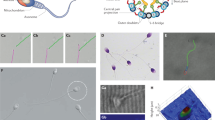Abstract
Using a combination of database screening and polymerase chain reaction analyses we have determined the sequence and structure of the human sperm tail associated gene SPAG4. SPAG4 is a 12-exon gene spanning approximately 5.2 kb on chromosome 20q11.23. It is expressed in a limited number of normal tissues, notably the pancreas and testis, but is switched on and greatly upregulated in a wide range of neoplastic tissues. The data therefore strongly suggests that SPAG4 expression is a potential clinically relevant cancer marker.




Similar content being viewed by others
References
Beck K, Brodsky B (1998) Supercoiled protein motifs: the collagen triple-helix and the alpha-helical coiled coil. J Struct Biol 122:17–29
Chomczynski P, Sacchi N (1987) Single-step method of RNA isolation by acid guanidinium thiocyanate-phenol-chloroform extraction. Anal Biochem 162:156–159
Gerdprasert O, O’Bryan MK, Nikolic-Paterson DJ, Sebire K, de Kretser DM, Hedger MP (2002) Expression of monocyte chemoattractant protein-1 and macrophage colony-stimulating factor in normal and inflamed rat testis. Mol Hum Reprod 8:518–524
Giulietti A, Overbergh L, Valxkx D, Decallonne B, Bouillon R, Mathi C (2001) An overview of real-time quantitative PCR: applications to quantify cytokine gene expression. Methods 25:386–401
Hagan I, Yanagida M (1995) The product of the spindle formation gene sad1+ associates with the fission yeast spindle pole body and is essential for viability. J Cell Biol 129:1033–1047
Lupas A (1997) Predicting coiled-coil regions in proteins. Curr Opin Struct Biol 7:388–393
Mount SM (1982) A catalogue of splice junction sequences. Nucl Acids Res 10:459–472
Navarro E, Espinosa L (2000) Improving quality of expressed sequence tag (EST) databases: recovery of reversed, antisense cDNA sequences. Microb Comp Genomics 5:17–24
O’Bryan MK, Loveland KL, Herszfeld D, McFarlane JR, Hearn MTW, de Kretser DM (1998) Identification of a rat testis-specific gene encoding a potential rat outer dense fibre protein. Mol Reprod Dev 50:313–322
O’Bryan MK, Sebire K, Meinhardt A, Edgar K, Keah H-H, Hearn MTW, de Kretser DM (2001) Tpx-1 is a component of the outer dense fibers and acrosome of rat spermatozoa. Mol Reprod Dev 58:116–125
Saiki R, Gelfand D, Stoffel S, Scharf S, Higuchi R, Horn G, Mullis K, Erlich H (1988) Primer-directed enzymatic amplification of DNA with a thermostable DNA polymerase. Science 239:487–491
Shao X, Tarnasky HA, Lee JP, Oko R, van der Hoorne FA (1999) Spag4, a novel sperm protein, binds outer dense-fiber protein Odf1 and localizes to microtubules of manchette and axoneme. Dev Biol 211:109–123
Tarnasky H, Gill D, Murthy S, Shao X, Demetrick DJ, van der Hoorn FA (1998) A novel testis-specific gene, SPAG4, whose product interacts specifically with outer dense fiber protein ODF27, maps to human chromosome 20q11.2. Cytogenet Cell Genet 81:65–67
Troutt AB, McHeyzer-Williams MG, Pulendran B, Nossal GJV (1992) Ligation-anchored PCR: a simple amplification technique with single-sided specificity. Proc Natl Acad Sci USA 89:9823–9825
Weghofer M, Karlic H, Haslberger A (2001) Quantitative analysis of immune-mediated stimulation of tumor necrosis factor-alpha in macrophages measured at the level of mRNA and protein synthesis. Ann Hematol 80:733–736
Author information
Authors and Affiliations
Corresponding author
Additional information
This work was supported by grants from the National Health and Medical Research Council (NH&MRC, #973218) of Australia. M.K.O’B. is the recipient of an R.D. Wright Fellowship from the NH & MRC (#143781). C.K. is the recipient of an A.P.A. scholarship from the Commonwealth of Australia
Rights and permissions
About this article
Cite this article
Kennedy, C., Sebire, K., de Kretser, D.M. et al. Human sperm associated antigen 4 (SPAG4) is a potential cancer marker. Cell Tissue Res 315, 279–283 (2004). https://doi.org/10.1007/s00441-003-0821-2
Received:
Accepted:
Published:
Issue Date:
DOI: https://doi.org/10.1007/s00441-003-0821-2




